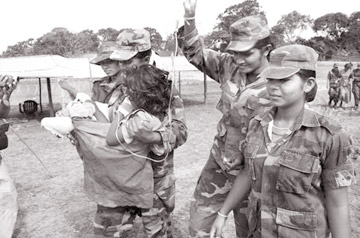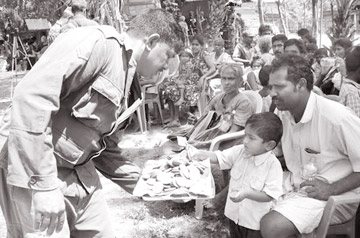Tales which pictures don't tell
by N. Sathiya Moorthy
As was to be expected under the circumstances, the Sri Lankan
Government has promptly dismissed the published pictures of LTTE leader
Prabhakaran's 12-year-old son Balachandran, before and after his killing
in the North in May 2009, as “lies, half-truths and speculation”. India,
which has a stake in it all, has reacted cautiously.
|

Armed Forces personnel carrying a child to safety during the
humanitarian operation |
New Delhi could not vouch for the authenticity of the pictures, is
how External Affairs Minister Salman Khurshid has put it.
The published pictures form a part of the upcoming documentary, No
War Zone: Killing Fields of Sri Lanka, to be shown in Geneva, timed to
coincide with the UNHRC session, due to discuss ‘accountability issues’
flowing from ‘Eelam War IV'.
The latter is part of the US effort, flowing from the UNHRC
resolution, with India voting in favour, last March. The former is an
effort at forcing New Delhi's hand to vote in favour of the follow-up
procedural resolution that the US has proposed to bring before this year
too.
The documentary seems intended to influence India. This has become
clear with the director of the BBC-Channel 4 documentary, Cullum Macrae,
declaring that the “film will test India over its next move on the UNHRC
resolution against Sri Lanka”.
Media reports quoting the director have said, “The new evidence in
the film is certain to increase the pressure on the Indian Government to
not only support a resolution on Sri Lanka and accountability, but also
ensure that it is robustly worded, and that it outlines an effective
plan for international action to end the impunity in Sri Lanka.”
If nothing else, such posturing raises the question if the pictures,
if not the film as a whole, is aimed at forcing New Delhi on a major
foreign policy concern with implications flowing from and into domestic
politics, particularly in relation to the South Indian State of Tamil
Nadu.
As was only to be expected, political parties and organisations in
the State have reacted promptly the way they were expected to do,
implying that efforts may already be on to prompt the Tamil Nadu polity
- and possibly, a section of the society - to force New Delhi into
taking decisions that are better left to the policy-maker.
Controversial at best
The film, aired by BBC's Channel 4 seems to be a sequel to what has
become an annual series, whose releases are timed to trigger tough
positions on Sri Lanka at successive sessions of the UNHRC over the past
couple of years. The producers have said that the film will be shown in
India too, possibly through local television channels, as was the case
with the earlier parts. In particular, great efforts went into producing
a Tamil version of the same, which was shown in TV channels in the
State, followed by television talk-shows that are picking up momentum.
|

Thousands of Tamil children were rescued and assisted by Sri
Lanka's Armed Forces per-sonnel during the humanitarian
operation |
However, these pictures are as controversial at best as the series
that were shown earlier. On earlier occasions, the Channel 4 fare put
out high figures of Tamil deaths, citing UN-commissioned reports, and
used pictures, as if to justify the voice-over.
The Sri Lankan Government had contested those figures, sticking to
the early goal and claims of ‘zero-casualty’, but modified by
individuals to a figure closer to the original 7,000 civilian deaths, as
enumerated by the UN itself.
Much will remain to be known when the new film is shown, but the
media promo - if one could describe the news reports with static
pictures of Balachandran, before and after his bullet-wound death, have
a different tale to tell, or what they do not tell. Like the earlier
version, it claims that the young and healthy boy was shot dead by the
Sri Lankan Armed Forces, at point-blank range. Forensic analysts who
studied the picture have confirmed ‘point-blank range’, but the
conclusion that it was the cruel handiwork of the Armed Forces would
still require independent confirmation.
Independent evidence
The possibility that the LTTE supremo or his close aides did not want
the little boy to fall into the hands of the ‘enemy’, whose ‘cruelty’
they had talked about, has to be ruled out through independent evidence
before any conclusions of the kind could be drawn.
The latest picture also pre-supposes and pre-disposes for the viewer
that the Sri Lankan Armed Forces were the killers, and had shot the boy
dead in a bunker. That it was an Army bunker, and not that of the LTTE,
has also to be proved. Another question to be answered is how the child
shown in the picture was sitting quietly in this place (forced as he may
have been under a soldier's gun, if the other assumption of the experts
in the news report is to be believed), and seems to be nibbling
something from a packet in the other hand, as if all was well all around
him - or, at least was not all that shocking and frightening, as it was
supposed to be.
At best, the forensic report could vouchsafe for the authenticity
that the earlier picture of the dead boy, and the new ones showing him
in flesh and blood, were taken by the same camera and formed a part of
the series. Otherwise, the claims, based on the assumptions by the
forensic expert, that the child may have been witness to the Armed
Forces’ killing of LTTE cadre, whose bodies were strewn along with that
of Balachandran in earlier films, too needs authentication of a
different kind. To the extent the forensic expert, extensively quoted,
has made assumptions that are not supported by scientific data, the
report cannot form the basis for governments across the world to base
their decisions on it. Since the film director has already indicated
that one purpose of the film may have been to force New Delhi's hand to
vote and act in a particular way, New Delhi has to be wary of efforts of
the kind more than ever. Decision has to be based on facts, not films!
The writer is a member of the Observer Research Foundation
Courtesy: Defence.lk
|



